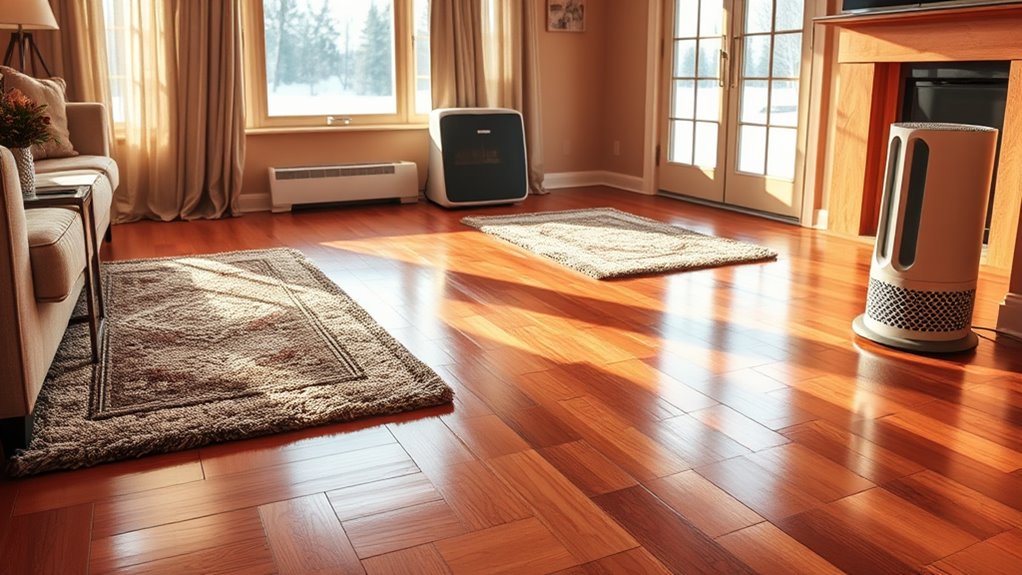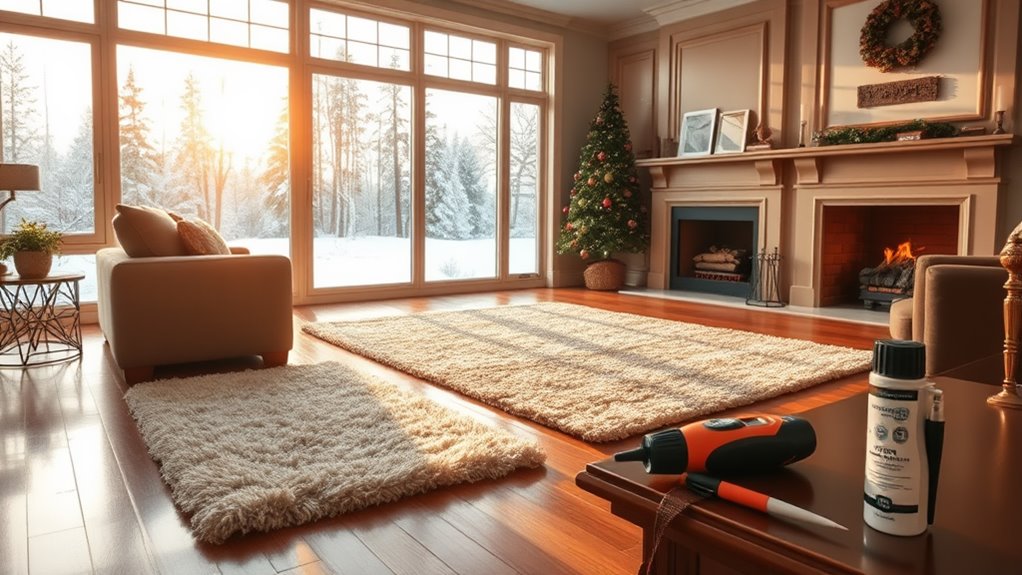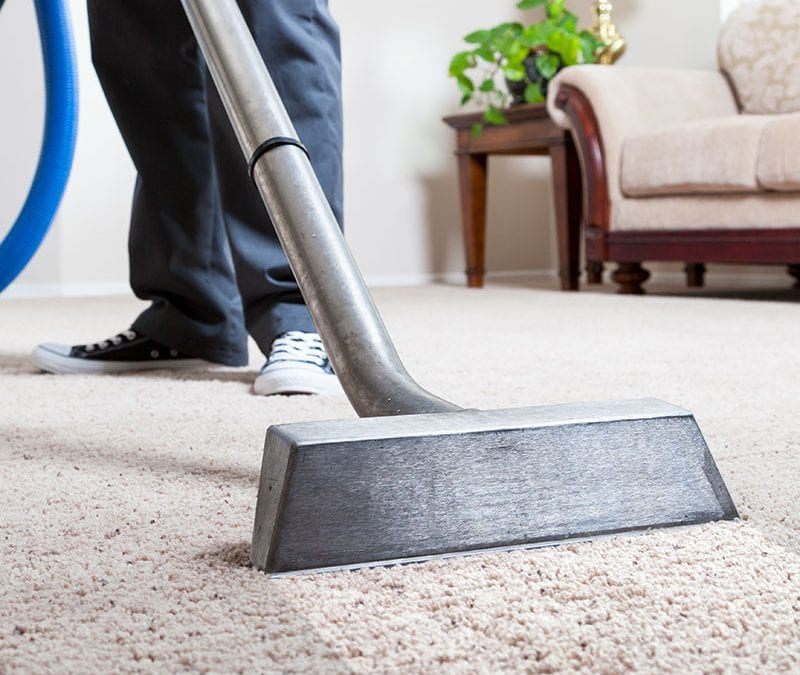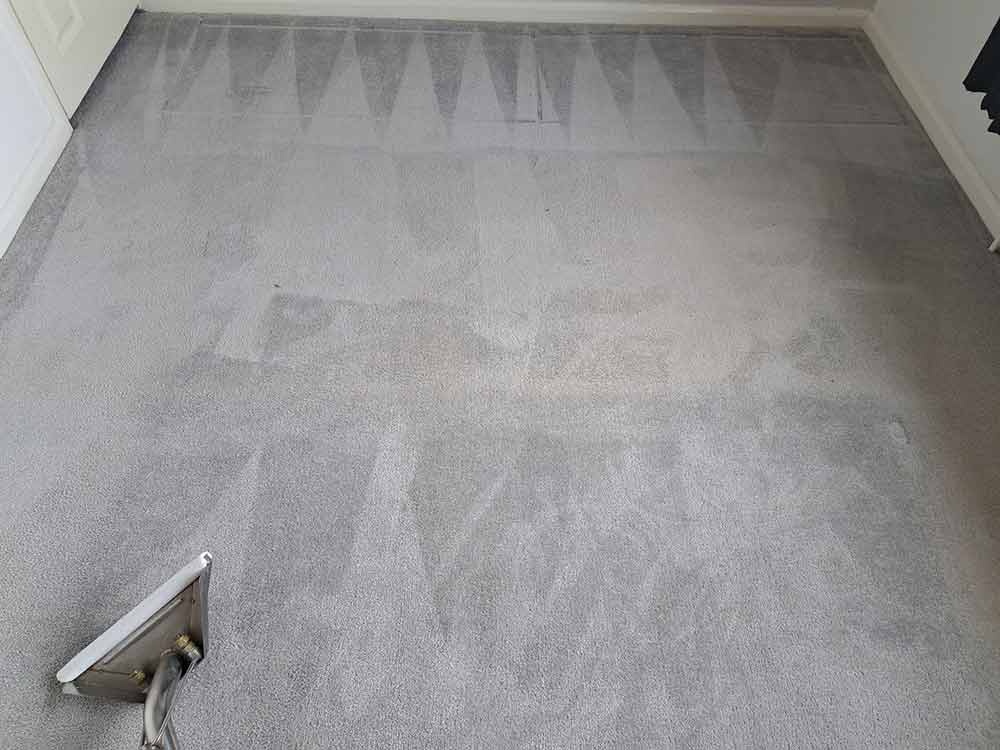Your hardwood floors can feel like they're under siege during winter, but they don't have to suffer. You need to take proactive steps to shield them from the harsh conditions that can cause permanent damage. From managing humidity levels to choosing the right entrance mats, every detail matters. If you think a few minor adjustments won't make a difference, think again. Explore how these strategies can enhance your floors' durability and keep them looking pristine all season long.
Understanding Low Humidity Effects
Low humidity can wreak havoc on your hardwood floors, causing a range of issues that can compromise both their appearance and integrity. When the air is dry, your flooring can lose moisture, leading to gaps and shrinking. If humidity measurement shows levels below 35%, you might notice significant gapping between planks as they contract. This not only detracts from the aesthetic appeal but can also lead to further damage.
Moreover, low humidity can cause your hardwood to become brittle, increasing the risk of splitting and cracking along the grain. Splitting can create splinters, posing a safety hazard. To prevent such issues, maintaining an ideal humidity range of 35% to 55% is vital.
To control moisture effectively, consider using a humidifier in your home, especially during dry months. Regularly monitor humidity levels with a hygrometer to guarantee they stay within the desired range.
Additionally, maintaining indoor temperatures between 60-80°F can help stabilize humidity, protecting your investment in hardwood flooring. Taking proactive steps in moisture control will save you from potential repairs and preserve the beauty of your floors.
Protecting Floors From Winter Debris
Winter can bring a host of debris into your home, making it essential to take proactive measures to protect your hardwood floors. Implementing effective debris prevention strategies can save you time and money in the long run.
| Action | Purpose | Tips |
|---|---|---|
| Entrance Mat Systems | Catch snow, dirt, and salt | Use mats with non-slip backings |
| Encourage Shoe Removal | Reduce tracked debris | Use boot trays for convenience |
| Designate Wet Areas | Keep water contained | Create a mudroom for changing footwear |
| Regular Maintenance | Prevent long-term damage | Clean and inspect floors regularly |
Additionally, practice winter cleaning techniques by immediately addressing spills and using waterproof mats under pet bowls. Avoid using salt excessively, as it can damage your floors; consider alternatives like sand. Regularly clean your mats and monitor humidity levels to prevent moisture issues. These steps will help maintain the beauty and integrity of your hardwood floors throughout the winter months.
Preventing Pipe Bursts
As you focus on maintaining your hardwood floors during the colder months, don't overlook the importance of safeguarding your plumbing from freezing temperatures. A pipe burst can lead to significant water damage, which can affect your floors.
Here are some practical tips to prevent this issue:
- Insulate Exposed Pipes: Use foam pipe insulation in attics, basements, and garages.
- Seal Leaks and Cracks: Check for air leaks near water supply lines and seal them with caulk or foam insulation.
- Maintain Consistent Indoor Temperature: Keep your thermostat set to at least 55 degrees, even when you're away.
- Drain and Disconnect Outdoor Hoses: Always drain and disconnect hoses before winter.
- Let Faucets Drip: Allow faucets connected to vulnerable pipes to drip slightly during extremely cold nights.
General Hardwood Maintenance Tips
Keeping your hardwood floors in top shape requires regular attention and care throughout the year.
Start your daily maintenance by sweeping or dusting your floors to remove dirt and crumbs. A microfiber dust mop works best, as it effectively picks up dust without scratching the surface. Be sure to spot clean any spills immediately to prevent dulling the finish, and keep your floors dry to avoid damage.
For weekly maintenance, vacuum every few days using a canister vacuum or by turning off the rotating brush on upright vacuums to protect your floors.
When it's time for a deeper clean, use an eco-friendly hardwood floor cleaner to wet mop, taking care not to use excessive water.
Incorporating seasonal cleaning routines can help maintain your floors' beauty. Inspect for wear and tear every month, and perform a deep clean every one to two months.
Avoid harsh chemicals—stick with mild soap or cleaners designed specifically for hardwood.
Additional Protection Strategies

To protect your hardwood floors during the winter months, implementing several key strategies can make a significant difference.
Focusing on moisture barriers and humidity control will help prevent damage and maintain the beauty of your floors.
Here are some effective additional protection strategies:
- Use Entry Mats: Place absorbent mats at all entry points to trap moisture and debris.
- Implement a No-Shoes Policy: Encourage family and guests to remove shoes to minimize moisture and dirt.
- Regular Cleaning: Promptly clean up any spills to prevent water from seeping into the wood.
- Protective Sealants: Apply high-quality sealants to create a barrier against moisture and stains.
- Humidifiers: Use humidifiers to maintain indoor humidity levels between 35-55%, preventing wood contraction and gaps.
Seasonal Preparation Steps
Winter's chill can pose significant challenges for hardwood floors, but with a few proactive steps, you can safeguard your investment.
Start by maintaining consistent indoor temperatures above 60 degrees Fahrenheit. This helps prevent excessive contraction and expansion of your wood floors. Regularly sweep or vacuum to remove dirt, snow, and debris that can scratch your floors or cause moisture damage.
Before winter sets in, conduct a thorough seasonal cleaning. Deep clean your hardwood floors to eliminate grime, and consider applying a hardwood floor polish for added protection.
It's also essential to monitor indoor humidity levels using a hygrometer, aiming for a range of 35-55 percent. A humidifier can help with humidity control, preventing dryness and cracking of the wood.
Inspect your floors for any gaps and fill them to deter moisture penetration. Additionally, seal drafts around windows and doors to maintain stable indoor conditions.
Finally, be proactive in wiping up spills immediately to avoid water damage. By following these seasonal preparation steps, you can effectively winter-proof your hardwood floors and enjoy their beauty for years to come.
Professional Guidance Recommendations

Professional guidance plays an essential role in maintaining the beauty and integrity of your hardwood floors throughout the winter months. By consulting with flooring experts, you can guarantee your floors remain in excellent condition, even in harsh conditions.
Here are some key recommendations:
- Inspect Regularly: Check for signs of wear or damage to catch problems early.
- Professional Refinishing: Schedule refinishing every 5-10 years to maintain structural integrity.
- Humidity Control: Keep indoor humidity between 35% and 55% to prevent wood shrinkage and cracking.
- Specialized Cleaning: Use cleaners designed specifically for wood floors to avoid damage.
- Immediate Cleanup: Clean up spills and snow immediately to prevent warping and discoloration.
Incorporating these professional insights into your winter maintenance routine will help protect your hardwood floors.
Additionally, consider using a humidifier and installing a hygrometer to monitor humidity levels. By taking these proactive steps, you'll not only maintain the aesthetic appeal of your floors but also extend their lifespan, saving you money on future repairs and refinishing.
Frequently Asked Questions
Can I Use a Humidifier in Every Room?
Yes, you can use a humidifier in every room. By strategically placing them, you'll maximize the humidifier benefits, ensuring consistent moisture levels throughout your home. Just remember to monitor and maintain each unit regularly.
What Types of Rugs Are Best for Winter Protection?
When considering winter protection, you'll find natural fiber rugs, especially thick ones, offer excellent insulation. Their density traps warmth, creating a cozy atmosphere while preventing cold air from seeping through your hardwood floors.
How Often Should I Check Humidity Levels During Winter?
During winter maintenance, you should check humidity levels daily. Consistent humidity monitoring helps prevent damage from dry air, ensuring your hardwood floors remain in good condition. Use a hygrometer to make this process easier and more accurate.
Can I Refinish My Floors Myself in Winter?
Yes, you can refinish your floors yourself in winter. Just remember floor refinishing techniques like proper sanding and humidity control, and consider winter flooring considerations to guarantee the best results during this season.
Are There Specific Cleaners for Winter Salt Stains?
Yes, you can use vinegar and water mixtures or specialized cleaning solutions for salt residue. Apply them with a microfiber mop, misting lightly to avoid soaking, and scrub gently to remove stubborn stains effectively.
Conclusion
By taking these winter-proofing steps, you can keep your hardwood floors looking great and lasting longer. Remember, "an ounce of prevention is worth a pound of cure." Maintain indoor humidity, protect against debris, and stay on top of regular cleaning. A little effort now will save you from costly repairs later. Embrace these tips to guarantee your floors withstand the chill, and enjoy a warm and inviting home all winter long!



